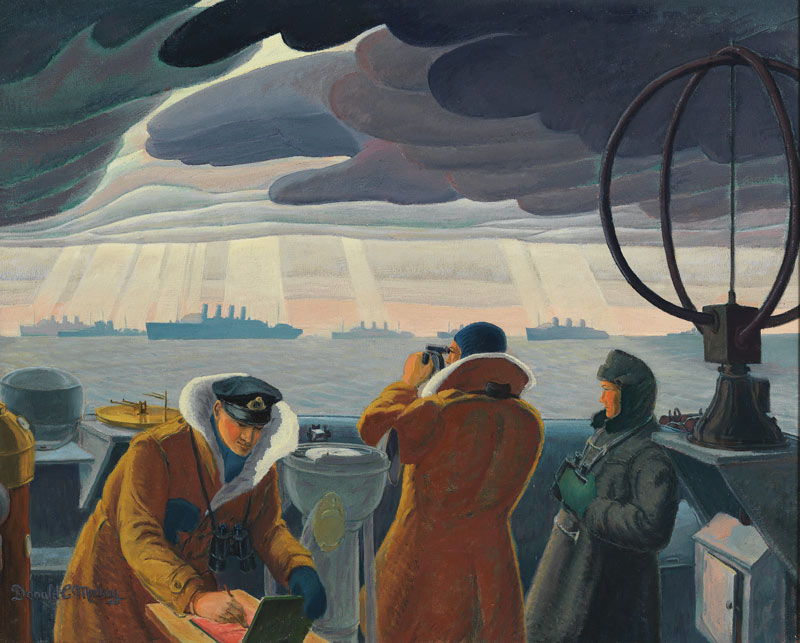
Two signalmen operate a light projector aboard HMCS Assiniboine in 1940. The practice was critical to secret convoy communication during the Second World War, as artist Donald Mackay depicts. [Lieutenant Donald Mackay/CWM/19710261-4245]
A North Atlantic wolf pack of 13 German U-boats that had stalked convoy ON-115 for days in July 1942, moved in for the kill on August 2-3. The poor weather, however, hampered the submarines’ ability to attack. Still, it was a tense situation.
The U-boats co-ordinated their movements via radio, but the escorts of the convoy lacked the shipboard high-frequency direction-finding equipment, known by the abbreviation HF/DF and nicknamed “huff-duff,” used to pinpoint their locations. The Germans homed in on their prey using similar technology or by intercepting radio signals between Allied ships.
The convoy’s escort group was Canadian and included the Royal Canadian Navy destroyers Saguenay and Skeena and the corvettes Agassiz, Louisburg, Wetaskiwin and Sackville. To keep the convoy in formation, signals between the escorts and the merchant vessels were transmitted via flashing light. Indeed, most signals pertaining to convoy movements were sent this way as it was harder for U-boats to intercept them.
The convoy ultimately lost only three merchant ships—a larger disaster had been averted because of the bad weather and the inexperience of some of the U-boat crews.
Meanwhile, the U-boats that were sighted, either by vigilant lookouts or radar, were attacked. Sackville targeted three, severely damaging two and forcing them to withdraw, including U-552, which was so badly damaged that it was, erroneously as it turned out, presumed sunk.
Coincidentally, Sackville, the last surviving corvette of its kind, was used as the model for the corvette in the Tom Hanks movie Greyhound, about a Second World War escort group. At the start of the film, a corvette is depicted communicating with an airplane via flashing light so the Germans can’t locate it.
By using light to communicate instead of radio, countless lives were saved in the Battle of the Atlantic. The signalling system has an interesting history—and it may be on the verge of a renaissance.
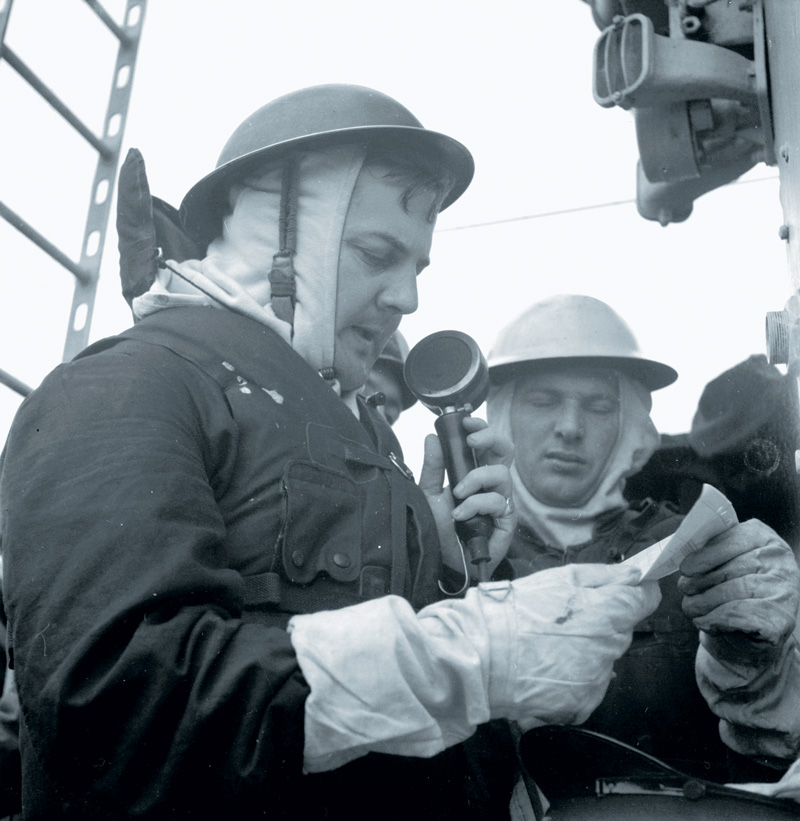
Lieutenant Stuart Keate reads a signal at sea aboard HMCS Uganda in 1945 (above). [Gerald Moses/DND/LAC/PA-116048]
By using light to communicate instead of radio, countless lives were saved in the Battle of the Atlantic.
Light signalling involves using a lamp with movable shutters so that a series of flashes can be produced. It uses Morse code—long flashes are dashes, shorter ones are dots—to represent the alphabet, numerals and selected punctuation. It can be used day or night and is visible at greater distances than semaphore flag signalling.
The Royal Navy began using light signalling in 1867 and it has largely been a staple of naval communication since. It was used extensively during both world wars, particularly during the Battle of the Atlantic, when it was the primary means of inter-ship signalling.
Inter-ship communication was important not just because it shared administrative messages, but because it was also the primary means of controlling the movements of convoys.
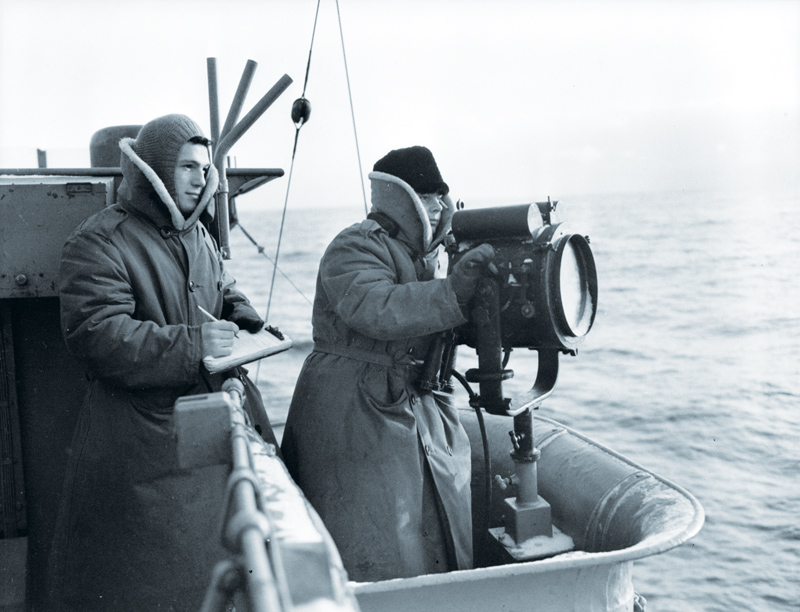
Two signalmen operate a light projector aboard HMCS Assiniboine in 1940. The practice was critical to secret convoy communication during the Second World War, as artist Donald Mackay depicts. [Gerald Moses/DND/LAC/PA-116048]
The most effective defence against U-boat wolf packs, convoys were kept together by a “screen” of protective naval ships that would stand guard. And grouping merchant ships together also made it harder for German submarines to find them in the first place. But, controlling them was difficult due to a shortage of RCN visual signallers. A humorous tale has it that one senior officer overseeing a convoy exasperatingly asked a corvette in the group by signal, “What are you doing?” The response: “Learning a lot.”
During the Second World War, the RCN also used infrared non-directional flashing light to communicate. This was the most secure form of signalling using flashing light, but unless the receiving ship had the equipment to read infrared, it couldn’t be seen.
Flashing light in all its forms continued to be used during the Cold War, but by 2007 its use was quickly declining. Technological innovations in radio and satellite communication combined to nearly replace flashing light, although it was still used occasionally for practising inter-ship communication.
Today, an outside visual signalling watch is no longer maintained by the RCN in all weather when sailing in company with other ships. Even during the early 1990s, flashing light skills were not what they once were.
One morning back then at a very early hour, an RCN reservist with light signalling experience was roused from the warmth of his bed to the bridge to read a light message coming from an American ship. None of the naval communicators on watch could read it. The officer, keen as are all of his ilk to demonstrate the efficiency of their watch, was impatient to know what the allies were saying. Half awake, the reservist mumbled that they were wishing the ship “good morning.” Then he went for a coffee. Not the stuff upon which modern naval operations hinge, you might say.

Artist Albert Cloutier depicts a Royal Canadian Air Force crew member signalling an escort vessel during WW II using more basic gear.[Albert Cloutier/CWM/19710261-1839]
Indeed, practised as it has been for some 150-plus years, flashing light signalling may have outlived its usefulness. Its main drawback is the low speed at which messages can be sent as an operator must send communications at the speed the recipient can read. Each word must be acknowledged by the receiving station via a flash of light before the next can be sent.
Although the NATO standard is eight words per minute, it’s usually sent much slower and never faster than six. Modern satellite communications have good bandwidth and are usually reliable, but they are still vulnerable to being intercepted. Radio messages, while still reliant on good atmospheric conditions and other factors, are now light-years ahead of where they were during the Second World War. And so, flashing light communication seems to have been overtaken by technology.
Still, light signalling continues to have some advantages. It cannot be intercepted unless someone is within its line of sight. And during periods of radio silence, flashing light can still be a relevant means of communication between ships. Could modern technology make it possible to send and receive light signals much faster?
Starting in 2016, the U.S. navy began developing a Flashing Light to Text Converter (FLTC). The device replaces operators and reads messages at much faster speeds. Initially, it used the existing xenon light bulbs in traditional signal lamps and replicated human rates of transmission, but later the bulbs were changed for LED lights that allow messages to be sent much faster. German researcher Harald Haas had first demonstrated the use of LED lights at very high speeds for communications purposes in 2011.
The FLTC system is being developed by the U.S. Office of Naval Research, the Naval Surface Warfare Development Center Panama City Division in Florida and Creative MicroSystems. A small camera captures the messages, which are then processed in real-time on a connected laptop. And an operator sending a signal simply types the message into a laptop—they don’t have to be trained in Morse code.
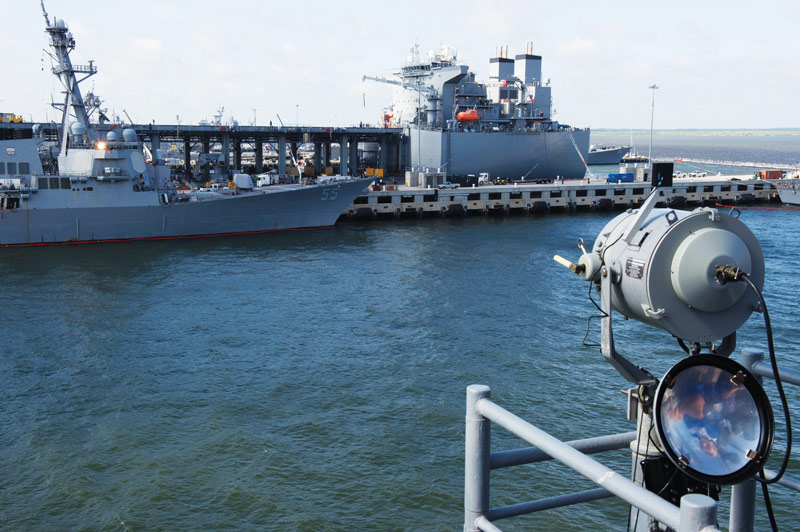
American sailors test the Flashing Light to Text Converter, the latest light-signalling tech (this page), in June 2017.[John Williams/U.S. Navy (2)]
In March 2020, a second trial was conducted with LED bulbs, which can send up to 1,200 characters per minute.
The first trials of the new system were conducted in June 2017 in Norfolk, Va., between two vessels using existing lights and a laptop connected to a sensor. This arrangement sent messages at about 120 characters a minute. Pre-drafted routine messages could speed up transmissions even further. In March 2020, a second trial was conducted with LED bulbs, which can send up to 1,200 characters per minute. It’s believed that LED can transmit signals at distances up to 12 nautical miles, or 22 kilometres.
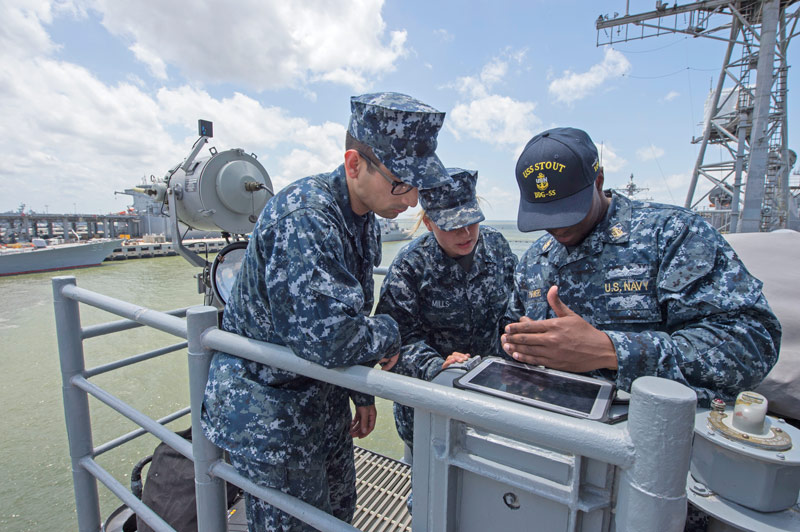
American sailors test the Flashing Light to Text Converter, the latest light-signalling tech (this page), in June 2017.[John Williams/U.S. Navy (2)]
The only way for an enemy to intercept one of these signals would be to position themselves so they could see the ships signalling each other or locate themselves behind one of the ships, in which case they would receive only half the communication. Of course, either would be difficult to accomplish without being visible to the vessels sending the message.
Enemies would also require the technology to read LED lights, which flash so quickly they appear as a steady beam to the human eye. There is no indication yet when the FLTC system will be installed on U.S. naval vessels, but it clearly works and would be a useful addition to a warship’s communications suite. Modern military communications tools, including radar, radio and satellite, are vulnerable to jamming. The world’s largest militaries have demonstrated significant capability in this area. These measures can seriously degrade the effectiveness of electronic communications or render them useless altogether. An FLTC could be easily installed and would help alleviate inter-ship communications challenges. It would also provide a backup messaging system.
For old-timers of the light signalling era, it’s encouraging to see the original technology being repurposed and improved for current and future operations. Light signalling isn’t dead yet. Will the RCN or other navies see the light?
Advertisement


















